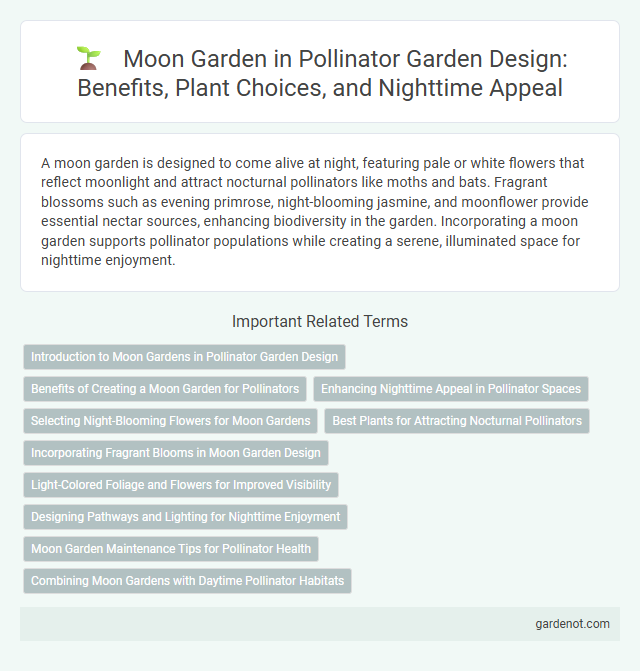A moon garden is designed to come alive at night, featuring pale or white flowers that reflect moonlight and attract nocturnal pollinators like moths and bats. Fragrant blossoms such as evening primrose, night-blooming jasmine, and moonflower provide essential nectar sources, enhancing biodiversity in the garden. Incorporating a moon garden supports pollinator populations while creating a serene, illuminated space for nighttime enjoyment.
Introduction to Moon Gardens in Pollinator Garden Design
Moon gardens enhance pollinator gardens by attracting nocturnal pollinators such as moths and bats with their pale, reflective flowers and sweet fragrances. Strategic placement of white or silver-hued plants like evening primrose, moonflower, and night-blooming jasmine increases visibility and scent dispersal at night. Incorporating moon garden elements enriches biodiversity and extends pollinator activity beyond daylight hours.
Benefits of Creating a Moon Garden for Pollinators
Creating a moon garden enhances nocturnal pollination by attracting night-active pollinators such as moths, bats, and certain beetles with its light-colored, fragrant flowers. This garden type supports biodiversity and extends foraging opportunities beyond daylight hours, promoting a healthier ecosystem. By providing continuous nectar sources, moon gardens contribute to sustaining pollinator populations crucial for plant reproduction and food production.
Enhancing Nighttime Appeal in Pollinator Spaces
Moon gardens amplify nighttime appeal in pollinator spaces by featuring white or pale-hued flowers that reflect moonlight, attracting nocturnal pollinators like moths and bats. Plants such as night-blooming jasmine, evening primrose, and moonflower provide strong fragrance and visual contrast, boosting pollinator activity during twilight hours. Integrating low-level solar or LED lighting enhances visibility without disrupting natural behaviors, fostering a thriving nighttime ecosystem within the garden.
Selecting Night-Blooming Flowers for Moon Gardens
Selecting night-blooming flowers for moon gardens enhances nighttime visibility and attracts nocturnal pollinators such as moths and bats. Plants like evening primrose, night-blooming jasmine, and moonflower offer fragrant blossoms that thrive in low light while supporting ecosystem biodiversity. Incorporating these species ensures a captivating and sustainable pollinator habitat under the moonlight.
Best Plants for Attracting Nocturnal Pollinators
Moon gardens featuring plants like evening primrose, night-blooming jasmine, and moonflower provide essential nectar and pollen for nocturnal pollinators such as moths, bats, and night bees. These fragrant, pale-colored flowers bloom at night, enhancing visibility and scent attraction under moonlight while supporting biodiversity. Incorporating native species like white hollyhock and nicotiana further promotes local ecosystem health by ensuring suitable habitats for nocturnal pollinating insects.
Incorporating Fragrant Blooms in Moon Garden Design
Fragrant blooms like night-blooming jasmine, moth orchids, and evening primrose enhance pollinator attraction in moon gardens by releasing scent during twilight. Integrating these aromatic plants supports nocturnal pollinators such as moths and bats, promoting biodiversity and healthy ecosystems. Selecting flowers with strong evening fragrances ensures a sensory-rich garden that thrives under moonlight.
Light-Colored Foliage and Flowers for Improved Visibility
Moon gardens emphasize light-colored foliage and flowers such as white moonflowers, pale jasmine, and silver-leafed artemisia to enhance nighttime visibility. These plants reflect moonlight, creating a luminous landscape that attracts pollinators like moths and nocturnal bees. Incorporating reflective textures and soft hues maximizes the garden's appeal and functionality after dusk.
Designing Pathways and Lighting for Nighttime Enjoyment
Design pathways in a pollinator moon garden using smooth, natural materials like flagstone or decomposed granite to enhance nighttime access for both visitors and nocturnal pollinators such as moths and bats. Incorporate soft, solar-powered LED lights or low-voltage landscape lighting along the paths to highlight key floral displays without disrupting the natural behavior of pollinators. Position lights carefully to minimize glare and use warm color temperatures to create a serene, inviting ambiance that supports nighttime garden activity and enjoyment.
Moon Garden Maintenance Tips for Pollinator Health
Moon garden maintenance for pollinator health involves regular watering and avoiding chemical pesticides to protect nocturnal pollinators like moths and bats. Plant selection should include night-blooming, fragrant flowers rich in nectar such as evening primrose and jasmine to attract and sustain pollinators. Mulching and deadheading help retain soil moisture and promote continuous bloom cycles, essential for ongoing pollinator support.
Combining Moon Gardens with Daytime Pollinator Habitats
Moon gardens emphasize fragrant, pale, and reflective flowers that attract nocturnal pollinators like moths and bats, enhancing nighttime biodiversity. Integrating daytime pollinator habitats with vibrant, nectar-rich blooms supports bees, butterflies, and hummingbirds during daylight, creating a continuous pollination cycle. This combination maximizes garden productivity and ecological balance by catering to diverse pollinator species around the clock.
Moon garden Infographic

 gardenot.com
gardenot.com